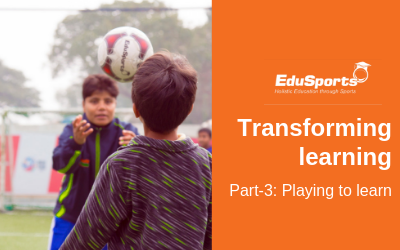“To succeed is to have failed” – learning from failures

Role of Physical Education in breaking stereotypes
Let us present a scenario of two children- a healthy child, and an obese child. If given a choice, we would all want to be the healthy child, which is an obvious one but this preference affects our behavior subconsciously.
A teacher picks a healthy child and expects him/ her to be brighter, a sports teacher selects a healthy child to complete school’s basketball team expecting his decision to be wise, a music teacher selects a healthy child to lead the choir, a child prefers to have a healthy friend and even a parent is biased towards a healthy child than the obese one.
A word of caution
Take a moment and ponder over what goes on in the head of the obese child who is constantly left out and not expected to perform. The moment we hear words like, “obese” or “overweight” tagged with a name; do we not suffix the name with words like lazy, lacking self-discipline, unsuccessful, no willpower, unattractive etc.?
Children come in all shapes and sizes
Children range from being chubby to skinny, healthy to not-so-fit. But do we accept them all, without them being target of stigmas, bullying and sniggers around the corners? And no, we are not targeting the obese only but children ranging from being scrawny to rotund; any child who does not fit the ‘normal’ tag can be the subject of a joke. Recently the granddaughter of the famous Bollywood actor Amitabh Bachchan was body shamed for being too skinny and she was of course devastated. These stereotypes about ‘abnormal’ bodies are highly pervasive, yet are often unchecked and reinforced in our society.
Role of Physical Education in breaking the weight stigma
Weight stigma, if left unattended, can impact a child’s social, emotional and academic growth and can exacerbate their physical health problems. Research on adolescents has documented that weight-based teasing is associated with low self-esteem and depression, and that overweight teens are more likely to be socially isolated. (Brownell et. al, 2005). Structured sports program with an all inclusive curriculum could be a great initiator to pull children out of their shells and help them shed away their inhibitions. The comprehensive PE program, when designed to not just engage children but to increase their enthusiasm and participation, helps in building positive mindsets. Thus, physical education becomes an essential contributor to the development of physical competence and fitness by helping children to make informed choices and understand the value of leading a physically active lifestyle.
Change of outlook for all stakeholders: Some specific messages for teachers, health professionals, and parents are outlined below:
Audience Audience specific message Prinicpal & Teachers Recognize the complexity of obese and underweight children and control their victimization in the school premises Keep a check on self and colleagues to ensure that no weight based assumptions are made to gauge a child’s intelligence, health status, or participatory skills Health professionals Reach out to all children, in particular physically inactive children and support them to participate in physical activities Be sensitive to the fact that children might have had negative experiences with other health professionals regarding their weight and inability to do PE Offer concrete advice beyond the PE curriculum, e.g., start an exercise program, eat healthy at home, etc., Parents Recognize small weight losses in your child which can result in significant health gains for him/ her Emphasize on behavior changes like eating habits, physical activity post school and be participatory rather than dictating regimes Creating healthy schools requires a combined effort from different stakeholders-Prinicpals- Health professionals- Parents. Together the emphasis should be on promoting health and not appearance. School-based structured sports program can be a big step towards the inclusion of obese children in physical activities. If each one of us takes the onus to make the children fit, no child will shun away from playing. And then who knows, the obese- turned- healthy children might give the ‘normal’ children a run for their sports. So, let all kinds of children play!
Reference:
Brownell KD, Puhl R, Schwartz MB, Rudd L, eds. Weight Bias: Nature, Consequences, and Remedies. New York: Guilford Publications; 2005 Latner JD, Stunkard AJ. Getting worse: The stigmatization of obese children. Obes Res. 2003; 11: 452-456. Puhl R, Brownell KD. Bias, discrimination, and obesity. Obes Res. 2001;9:788-805. //www.obesityaction.org/educational-resources/resource-articles-2/childhood-obesity-resource-articles/childhood-obesity-and-stigma https://www.ncbi.nlm.nih.gov/pmc/articles/PMC2866597/






